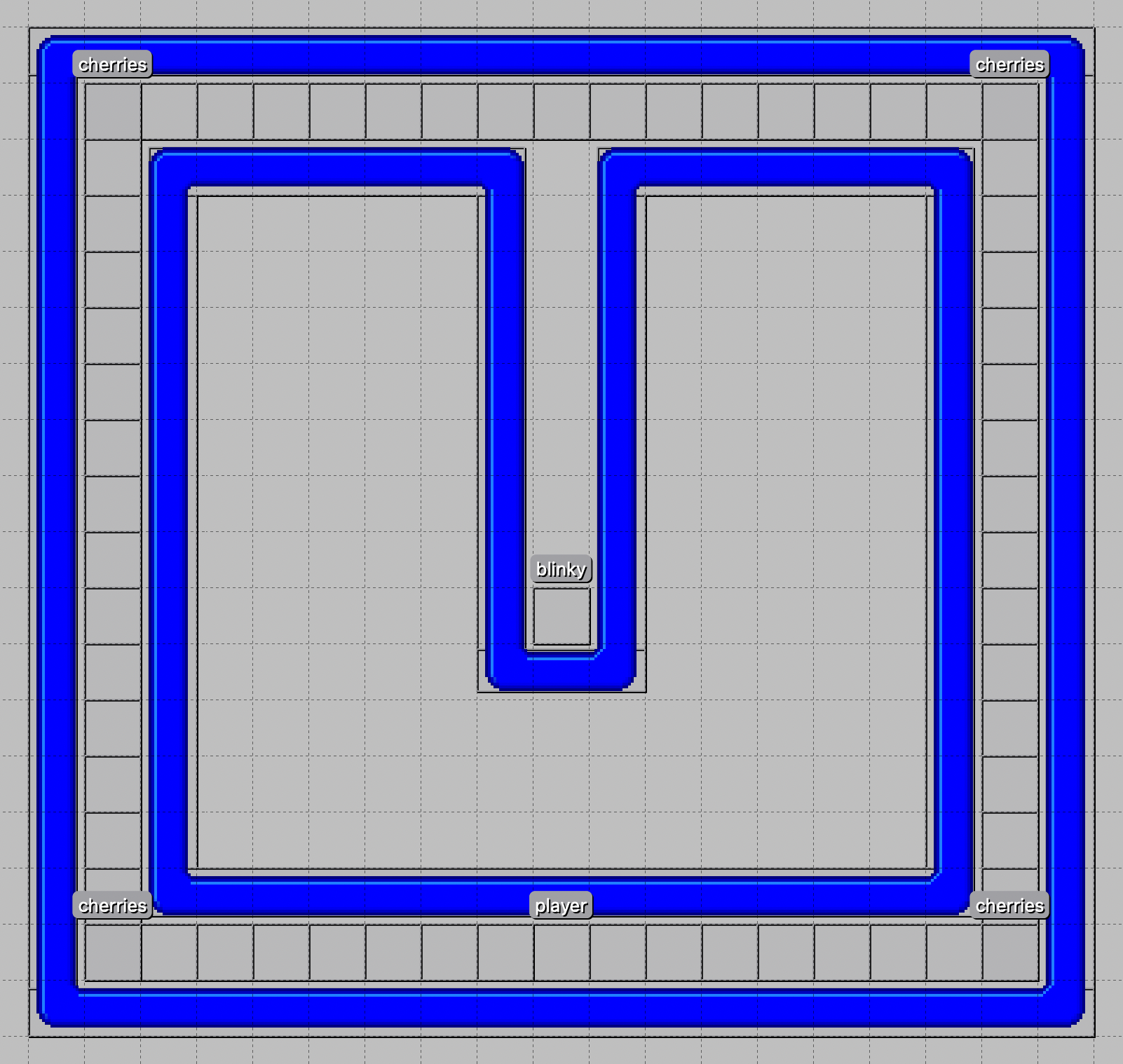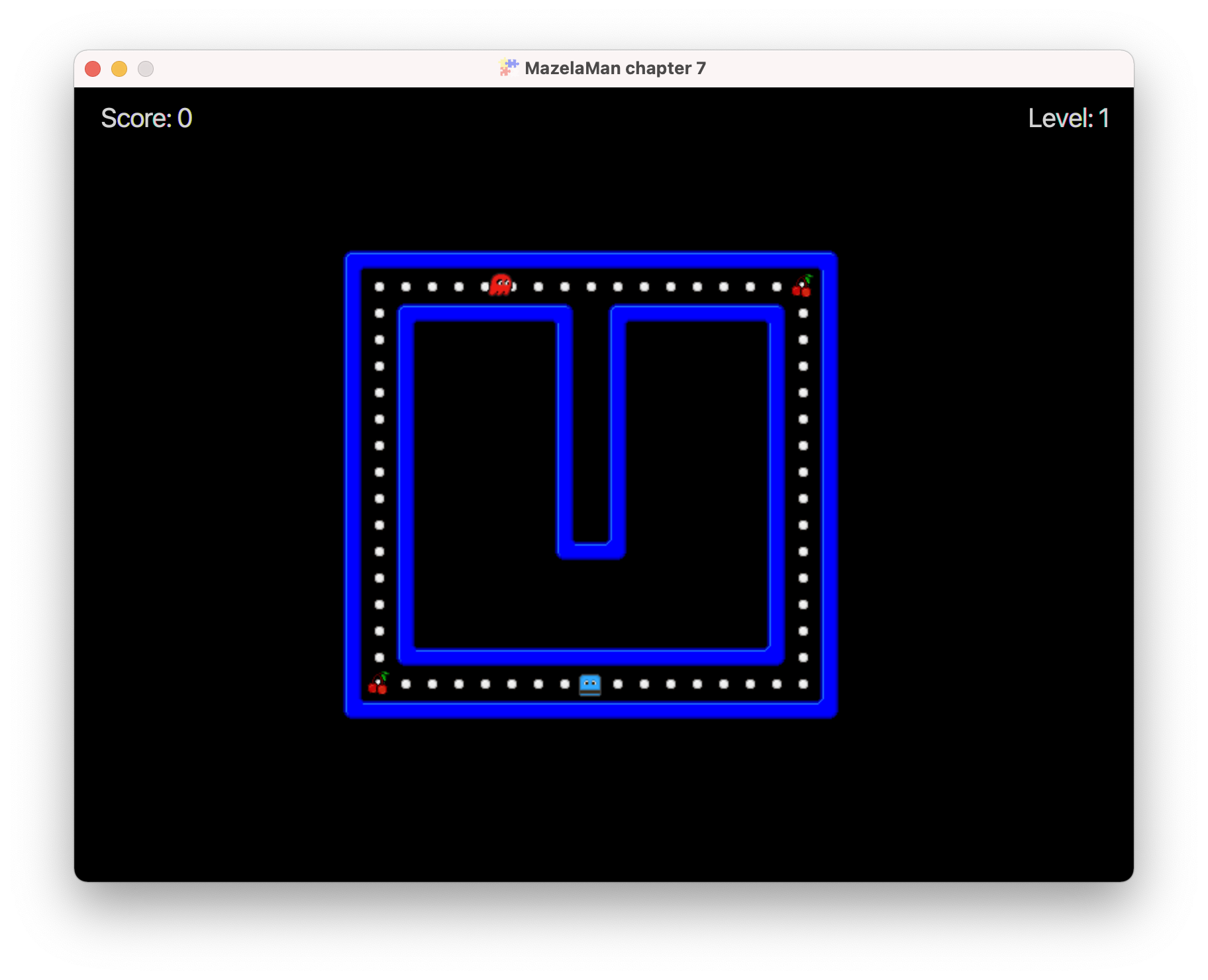07. Bonus Points
In this chapter we will add cherries that enable the player to earn bonus points. The cherries will spawn at well-defined spawn-points at random points in time, and remain visible for ten seconds before they disappear.
Adding Cherries in Tiled
As usual, we start in Tiled. This time, you need to edit both level 1 and level 2, and any additional levels you may have created. Or you can copy the level files from the next chapter. We will not add any cherries, but rather cherry spawn-points to the level files. The spawn-points will exist through the whole level even though the spawned cherries will not. I added spawn-points in the corners of the level 1 maze, and set the type string to “CherrySpawnPoint”.

We also need to copy the cherry image to the textures folder.
Entity Factory
The next step is as always to create a new spawn method for the object we added to the level file. In this case we will actually add two spawn methods - one for the cherry spawn-point, and one for the cherries.
@Spawns("CherrySpawnPoint")
public Entity spawnCherrySpawnPoint(SpawnData data) {
return FXGL.entityBuilder(data)
.with(new CherrySpawnComponent())
.build();
}
@Spawns("Cherry")
public Entity spawnCherry(SpawnData data) {
return FXGL.entityBuilder(data)
.type(EntityType.CHERRY)
.viewWithBBox("cherry.png")
.collidable()
.build();
}
The cherry spawn-point is an invisible entity, so it does not have any view. The only
thing it does have is a CherrySpawnComponent, which we will create shortly. The
cherries are collidable entities with a view, and a bounding box created from the view.
The cherries are of entity type CHERRY to enable them to be picked up by the player.
The EntityType enum constant CHERRY must also be created.
CherrySpawnComponent
Here is the entire CherrySpawnComponent:
public class CherrySpawnComponent extends Component {
private static final Random RANDOM = new Random();
@Override
public void onUpdate(double tpf) {
// Spawn a cherry randomly if there is not a cherry already
if (RANDOM.nextInt(1000) == 0 && noCherryAt(entity.getX(), entity.getY())) {
Entity cherry = FXGL.spawn("Cherry", new SpawnData(entity.getX(), entity.getY()));
despawnLater(cherry);
}
}
private void despawnLater(Entity cherry) {
FXGL.getGameTimer().runOnceAfter(cherry::removeFromWorld, Duration.seconds(10));
}
private boolean noCherryAt(double x, double y) {
return FXGL.getGameWorld().getEntitiesByType(EntityType.CHERRY)
.stream()
.noneMatch(e -> e.getX() == x && e.getY() == y);
}
}
The CherrySpawnComponent has an onUpdate method that is called every frame. Every
time that method is called, there is one chance in 1000 to spawn a cherry, if there is
not already a cherry at that position. Note that the component does not need to remember
its own position, because it has access to the entity it is part of, and the entity has
the position.
If we are lucky, and a cherry should be spawned, onUpdate calls one of the spawn
methods in FXGL, which in turn uses some reflection magic to call the spawnCherry
method in our entity factory. We get back a reference to the created entity, and this
reference is passed to a method that starts a timer that triggers after 10 seconds, and
then removes the cherry again.
Using the built-in game timer has the advantage that the call to removeFromWorld is
performed on the JavaFX Application Thread. JavaFX and FXGL require all calls to the
framework to be made on the JavaFX Application Thread to work properly. Normally, that
is no problem because all callback methods are called on this thread, but creating your
own timer would involve a background thread.
The helper method noCherryAt just checks that there is no entity of type CHERRY at
the specified position. An alternative implementation of this method could have retrieved
all entities at the specified position using getEntitiesAt and then checked that none
of them was of type CHERRY.
Collision Handling
The player-cherry collision handler is very straight forward, and I almost feel it unnecessary to state it here, but anyway, here it is:
physics.addCollisionHandler(new CollisionHandler(EntityType.PLAYER, EntityType.CHERRY) {
@Override
protected void onCollisionBegin(Entity player, Entity cherry) {
cherry.removeFromWorld();
FXGL.inc("score", 100);
}
});

This completes this chapter. Move on to the next chapter where we will add sound to the game.